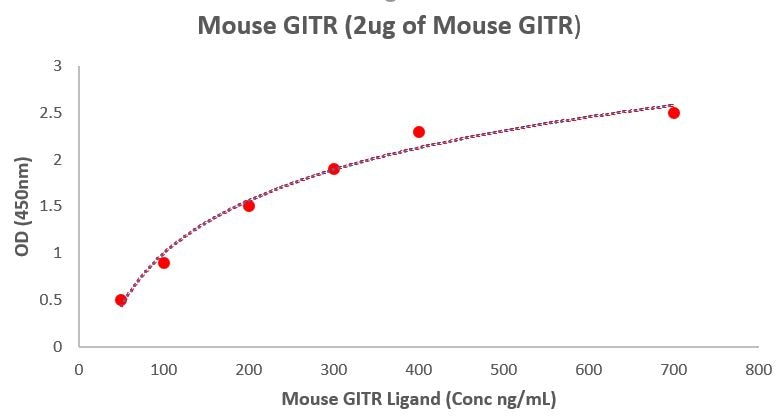| Reactivity | MuSpecies Glossary |
| Applications | Binding Activity |
| Format | Carrier-Free |
| Details of Functionality | Measured by its binding ability in a functional ELISA. Immobilized rmGITR/Fc Chimera at 2 µg/mL (100 µL/well) can bind rmGITR Ligand with a linear range of 0.8-50 ng/mL. |
||||||||
| Source | Mouse myeloma cell line, NS0-derived mouse GITR/TNFRSF18 protein
|
||||||||
| Accession # | |||||||||
| N-terminal Sequence | Ser22 |
||||||||
| Structure / Form | Disulfide-linked homodimer |
||||||||
| Protein/Peptide Type | Recombinant Proteins |
||||||||
| Gene | Tnfrsf18 |
||||||||
| Purity | >95%, by SDS-PAGE under reducing conditions and visualized by silver stain |
||||||||
| Endotoxin Note | <1.0 EU per 1 μg of the protein by the LAL method. |
| Dilutions |
|
|
| Theoretical MW | 42 kDa (monomer). Disclaimer note: The observed molecular weight of the protein may vary from the listed predicted molecular weight due to post translational modifications, post translation cleavages, relative charges, and other experimental factors. |
|
| SDS-PAGE | 55-65 kDa, reducing conditions |
|
| Reviewed Applications |
|
| Storage | Use a manual defrost freezer and avoid repeated freeze-thaw cycles.
|
| Buffer | Lyophilized from a 0.2 μm filtered solution in PBS. |
| Purity | >95%, by SDS-PAGE under reducing conditions and visualized by silver stain |
| Reconstitution Instructions | Reconstitute at 100 μg/mL in sterile PBS. |
| Images | Ratings | Applications | Species | Date | Details | ||||||
|---|---|---|---|---|---|---|---|---|---|---|---|

Enlarge |
reviewed by:
Verified Customer |
Binding assay/Protein-protein interaction | 06/09/2019 |
Summary
|
|||||||

Enlarge |
reviewed by:
Verified Customer |
Binding assay/Protein-protein interaction | 11/16/2018 |
Summary
Comments
|
The concentration calculator allows you to quickly calculate the volume, mass or concentration of your vial. Simply enter your mass, volume, or concentration values for your reagent and the calculator will determine the rest.
5 | |
4 | |
3 | |
2 | |
1 |
| Verified Customer 06/09/2019 |
||
| Application: | Binding assay/Protein-protein interaction | |
| Species: |
| Verified Customer 11/16/2018 |
||
| Application: | Binding assay/Protein-protein interaction | |
| Species: |